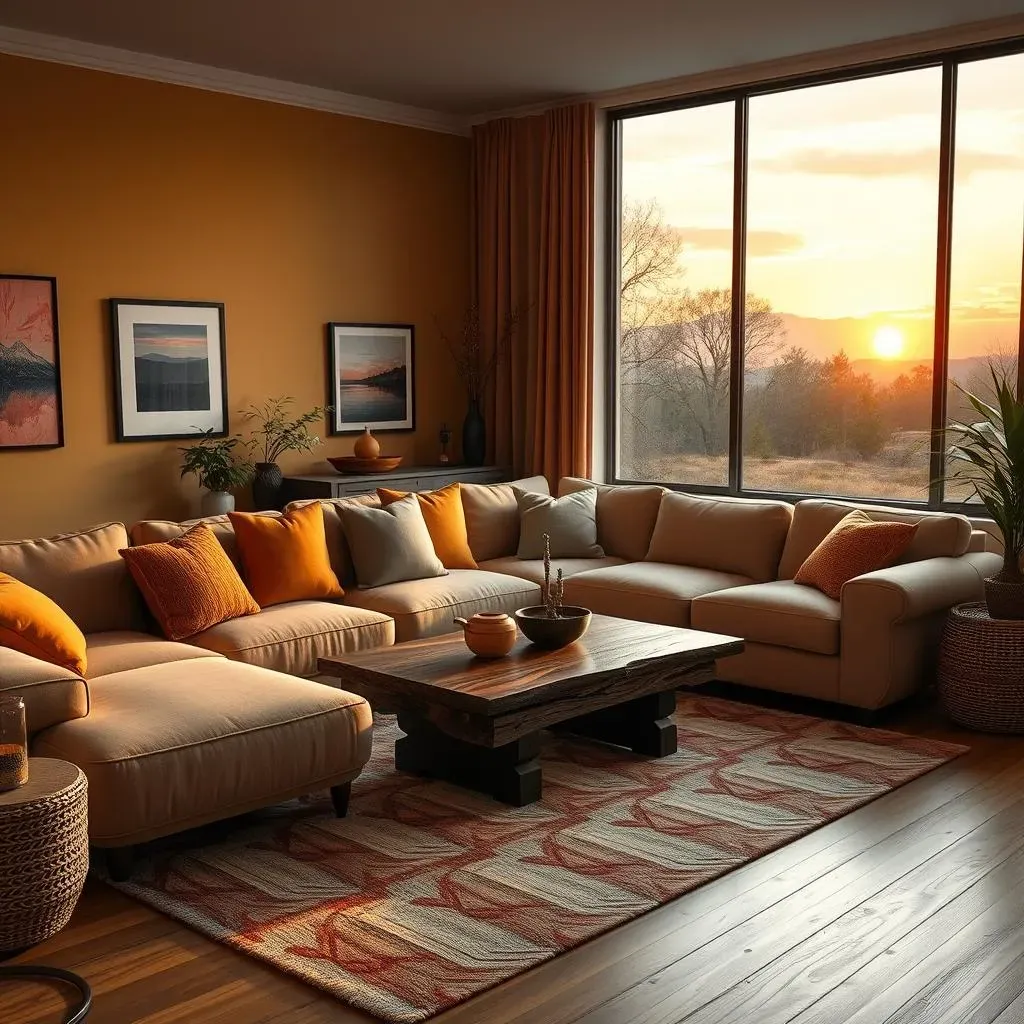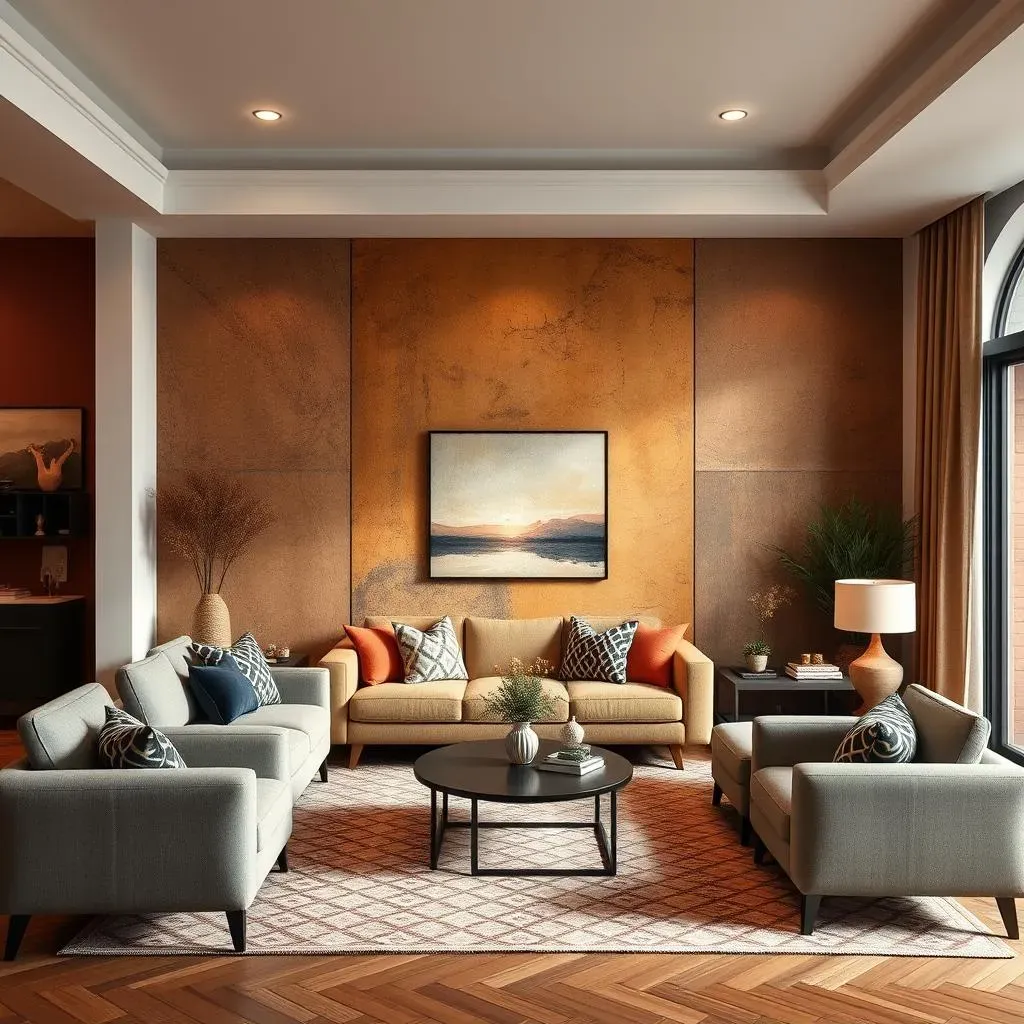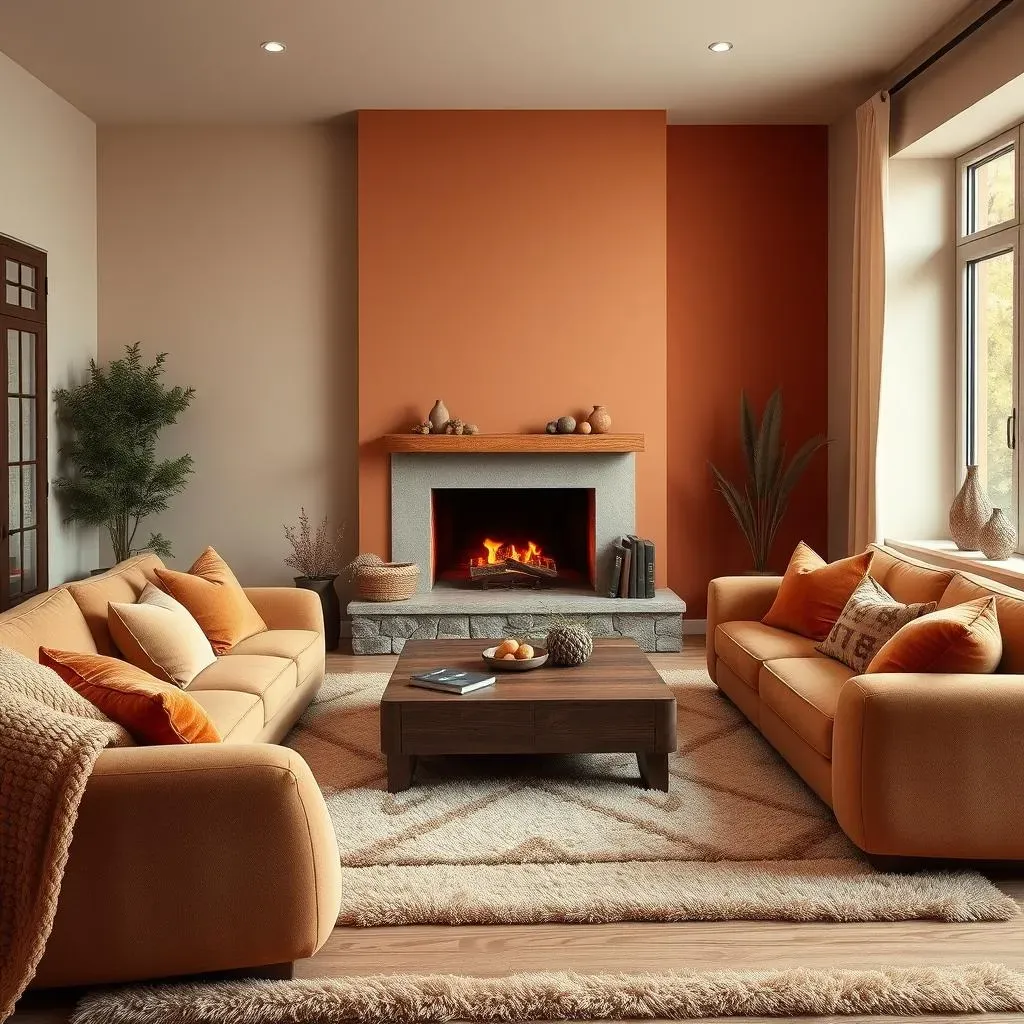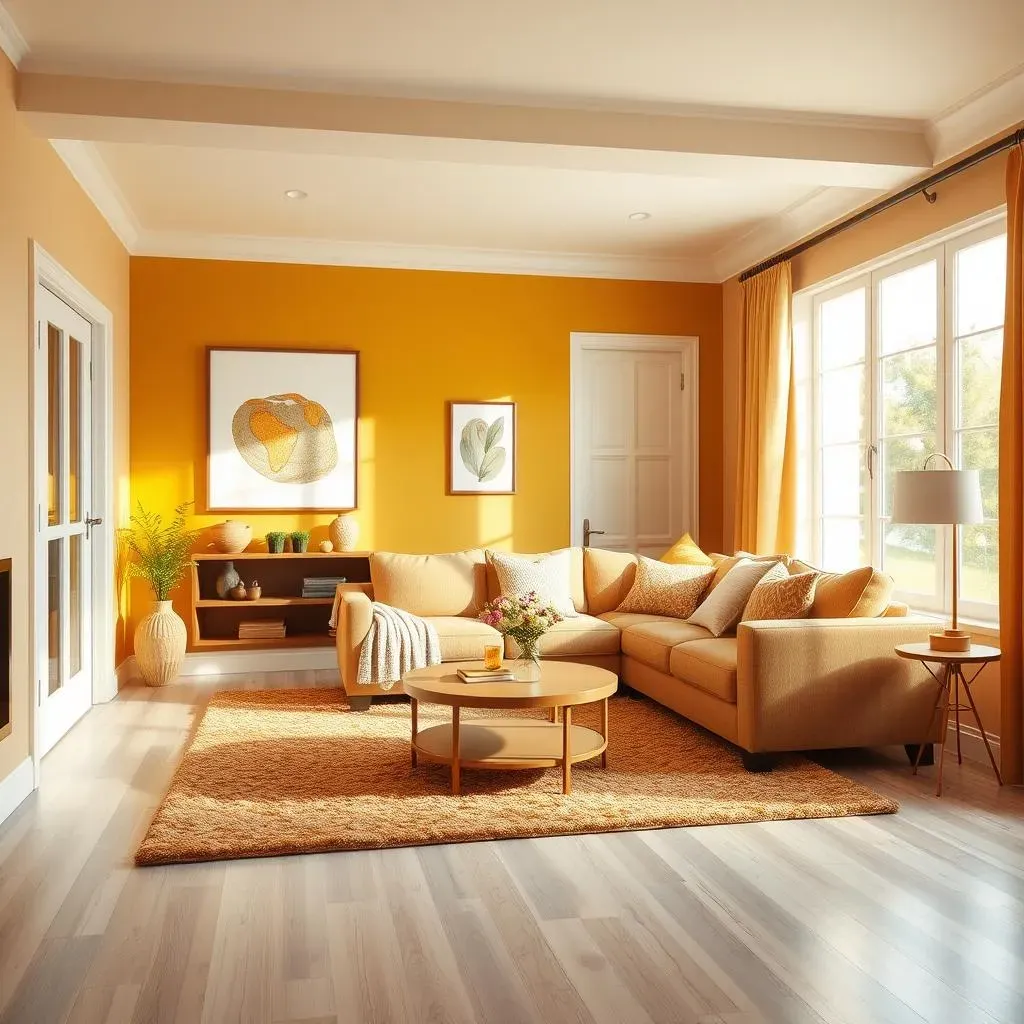Table of Contents
Ever walk into a living room and just feel…blah? Like it's missing something? Maybe it's a lack of warmth or character. I get it. I've been there, staring at beige walls, wondering how to make my space feel inviting. The good news is, a little paint and a well-placed accent wall can totally transform a room. This isn't about complicated renovations or spending a fortune. It's about using color and design to create a space that feels like a warm hug. We're diving into the world of "warm living room paint ideas with accent wall" to show you how to choose the perfect colors, pick the right wall, and combine them for maximum coziness. Think mustard yellows paired with terracotta, soft beiges with deep burgundies, or even a pop of teal against a creamy white. We'll explore different styles, materials, and real-world examples to help you envision the possibilities. So, ditch the drab and get ready to create a living room that’s not only beautiful, but also a place where you actually want to hang out.
Choosing the Right Warm Colors for Your Living Room

Choosing the Right Warm Colors for Your Living Room
Understanding Warm Tones
Okay, so you're thinking about warm colors, but what does that *actually* mean? We're not just talking about the temperature in your house. Warm colors are the ones that make you feel cozy, like you're wrapped in a blanket. Think about the colors of a sunset: reds, oranges, yellows, and even some browns. These hues have a way of making a room feel inviting and comfortable. They can make a large space feel more intimate or a small space feel more snug. When picking your warm base, consider the amount of natural light your living room gets. If you have a lot of light, you can go for a deeper, richer tone. If not, lighter shades will help keep the room from feeling dark and cramped. For example, a soft beige or a creamy white can be a fantastic base that you can build upon.
Now, don't get me wrong, warm doesn't mean you need to go full-on Tuscan villa. You can totally keep it modern and chic while still embracing warmth. The key is to think about undertones. Even a seemingly "cool" color can have a warm undertone that will do the trick. For instance, a gray with a hint of yellow or a muted olive green can bring a surprising level of warmth to a space. It's also worth thinking about the other elements in your room, like the furniture, flooring and decor. You want your paint to complement, not clash with, everything else. So, before you grab the paintbrushes, take a good look at what you've already got going on.
Color Family | Examples | Feeling |
|---|---|---|
Yellows | Mustard, Gold, Cream | Cheerful, Optimistic, Sunny |
Reds | Terracotta, Burgundy, Rust | Passionate, Energetic, Cozy |
Oranges | Peach, Coral, Amber | Friendly, Playful, Inviting |
Browns | Beige, Taupe, Chocolate | Earthy, Grounded, Comfortable |
Finding Your Perfect Palette
Okay, so you've got a handle on what warm colors are. Now, how do you pick the *right* ones for *your* living room? It's not just about randomly picking a color you like. It's about creating a palette that works harmoniously. Start by thinking about the mood you want to create. Do you want a space that's energetic and lively, or one that's calm and relaxing? For a more lively feel, consider a combination of a bold yellow or orange with a softer, more neutral tone. For a relaxing vibe, think about pairing a muted green or blue with a warm beige or cream. Don't be afraid to experiment with different combinations. Grab some paint samples and test them out in your space. Remember, colors can look different in different lighting, so it's crucial to see how they look in your living room at different times of the day.
Also, think about the size of your living room. If you have a small space, you may want to stick with lighter shades to avoid making the room feel too cramped. If you have a larger space, you have more freedom to play with bolder colors and deeper tones. And, hey, don’t feel pressured to follow the trends. What really matters is that you pick colors that you love and that make you feel good. It’s your living room, after all! So, get inspired by what you see, but ultimately, go with your gut.
- Consider the lighting: Natural and artificial light can change how colors appear.
- Think about the mood: Do you want a lively space or a relaxing one?
- Test samples: Always test paint samples on your walls before committing to a color.
- Don't follow trends blindly: Choose colors that you love.
- Consider the size of your space: Lighter colors can make small spaces feel larger.
Creating a Focal Point: Accent Wall Ideas

Creating a Focal Point: Accent Wall Ideas
Alright, so you've got your warm base colors sorted, now let’s talk about making a statement. That's where the accent wall comes in, my friend. It’s like the rockstar of your living room, the one that grabs everyone's attention. Think of it as a way to add some drama, some flair, and maybe even a bit of your personality. Now, you might be thinking, "Okay, but which wall? And what do I do with it?" Well, the most common choice is the wall that’s naturally the focal point of the room, like the one behind your sofa or the one with the fireplace. But, honestly, there are no hard and fast rules here. It’s about what *you* want to highlight. Maybe you have a cool architectural feature you want to show off, or perhaps you just want to create a visual anchor in the room. It's all about your vision.
Now, when it comes to actually creating that accent wall, you've got options. Lots of them. Paint is the easiest and most affordable way to go, and you can get really creative with colors and patterns. Think about using a darker shade of the same color you used for the rest of the room, or going for something totally different, like a bold pop of blue or green. Wallpaper is another great option, especially if you want to add texture or a cool pattern. And if you're feeling extra adventurous, you can even use paneling or other materials to create a really unique look. The key is to not be afraid to be a bit bold and to choose something that really speaks to you. After all, this is your chance to make your living room truly yours.
Material | Pros | Cons |
|---|---|---|
Paint | Affordable, easy to apply, wide range of colors | Can be less visually interesting than other options |
Wallpaper | Adds texture and pattern, can be very impactful | Can be more expensive, can be difficult to install |
Paneling | Adds dimension and texture, can be very unique | Can be more expensive, requires some DIY skills |
Other materials | Adds unique texture and look | Can be more expensive and hard to install |
You know, I once helped a friend who was terrified of color transform her living room. She always stuck to beige and gray, but I convinced her to try a deep teal accent wall. It was like she was a different person! Suddenly, the space had a personality, and she was actually excited to spend time in there. It just goes to show you that a little bit of color can go a long way. So, if you're feeling hesitant, just remember that it's paint, you can always change it! Don't let the fear of making a "mistake" hold you back from creating a space you truly love. This is your canvas, go wild.
And hey, if you’re still feeling a bit lost, don’t worry. We’ll dig into some specific color combinations and design ideas that can help spark your creativity. From bold, statement walls to subtle, textured accents, there's something for everyone. The key is to find that balance between what you love and what makes your space feel truly special. So, are you ready to take your living room to the next level? I know I am.
- Choose the right wall: Focus on the natural focal point or a wall you want to highlight.
- Consider different materials: Paint, wallpaper, and paneling can all create unique looks.
- Don't be afraid to be bold: An accent wall is your chance to make a statement.
- Experiment with patterns: Wallpaper or paint patterns can add visual interest.
- Remember, it's your space: Choose something you love and that reflects your personality.
Combining Warm Paint and Accent Walls for a Cozy Feel

Combining Warm Paint and Accent Walls for a Cozy Feel
The Art of Harmonious Hues
Okay, so you've picked your warm base color and you've got a killer accent wall idea brewing. But how do you make sure they actually work together? It's all about creating harmony, my friend. Think of it like a perfectly balanced meal – you don't want one flavor to overpower the others. The same goes for your living room. You want your base color and your accent wall to complement each other, not clash. A good rule of thumb is to choose an accent wall color that's either a shade darker or lighter than your base color, or something that shares a similar undertone. For instance, if you’ve got a creamy beige base, you could go for a terracotta accent wall for a cozy, earthy feel. Or if your base is a soft mustard yellow, a deeper gold or even a warm gray can work wonders. It's all about finding that sweet spot where the colors feel like they belong together.
But, don't feel like you have to stick to the same color family. Sometimes, the most interesting spaces are the ones that break the rules a little. You can absolutely pair a warm neutral with a bold pop of color, as long as it's intentional. For instance, a warm grey living room can look amazing with a rich, deep blue accent wall. The key is to make sure that the colors have something in common, whether it's the undertone, the saturation, or even just the feeling they evoke. Think about the overall mood you're trying to create and let that guide your choices. And, remember, you can always test out different color combinations with paint samples before making a final decision. It’s all part of the fun.
Base Color | Accent Wall Ideas | Mood |
|---|---|---|
Creamy Beige | Terracotta, Deep Burgundy, Olive Green | Cozy, Earthy, Relaxing |
Soft Mustard Yellow | Gold, Warm Gray, Deep Teal | Cheerful, Inviting, Sophisticated |
Light Gray with Warm Undertones | Deep Blue, Charcoal, Forest Green | Modern, Calming, Elegant |
Warm White | Peach, Coral, Light Brown | Fresh, Welcoming, Natural |
Creating Coziness Through Texture and Light
Now, color is just one part of the equation when it comes to creating a cozy living room. Texture and light also play a huge role. Think about how a soft, plush rug makes you feel versus a hard, cold floor. Texture adds depth and interest to a room, and it can make a space feel so much more inviting. Consider adding textured elements to your accent wall, like a wallpaper with a subtle pattern or even a wood paneling. You can also bring in texture through your furniture and décor. Think about soft throws, velvet pillows, and woven baskets. These kinds of elements can make a huge difference in how cozy your living room feels. And don’t forget about lighting. The right kind of lighting can make a space feel warm and inviting or cold and harsh. Natural light is always the best, but if you don’t have a lot of natural light, you can use warm light bulbs and lamps to create a cozy atmosphere.
You know, I once saw a living room that was all painted in the same shade of gray. It was so bland and uninviting. But then the homeowner added a textured wallpaper to the accent wall and brought in some warm lighting. Suddenly, the room felt totally different! It was amazing how much of a difference those small changes made. So, when you're planning your living room, don't forget the details. Think about how all the different elements of the room work together to create a cohesive and cozy space. It's not just about the paint; it’s about creating an experience. And remember, you don't have to do everything at once. Start with the paint and accent wall, and then build from there. It's a process, so enjoy the journey!
- Incorporate textured elements: Use wallpaper, paneling, or textured décor to add depth.
- Use soft and warm lighting: Create a cozy atmosphere with the right light bulbs and lamps.
- Add soft furnishings: Think plush rugs, velvet pillows, and woven throws.
- Consider natural light: Maximize natural light to enhance the warmth of the room.
- Don't be afraid to experiment: Play with different textures and lighting to find what works best for you.
RealWorld Examples: Warm Living Room Paint with Accent Walls

RealWorld Examples: Warm Living Room Paint with Accent Walls
The Cozy Cottage
Let’s start with a classic: the cozy cottage look. I’m picturing a living room with soft, creamy white walls – almost like the color of vanilla ice cream. Now, for the accent wall, imagine a deep, rich terracotta. It's like bringing the warmth of the earth inside. This combination is so inviting, it practically begs you to curl up with a good book and a cup of tea. The terracotta adds a grounded, comforting feel, while the creamy white keeps everything bright and airy. To complete the look, you could add some natural wood furniture, a plush, textured rug, and some warm lighting. It’s the kind of space that makes you feel instantly relaxed and at home.
I saw a picture online of a living room with this exact color scheme, and it blew me away. They had a beautiful brick fireplace on the terracotta accent wall, and it just added another layer of texture and warmth. It was so simple, yet so effective. They also added some woven baskets and some cozy blankets, and it just made me want to move right in. It's a great example of how you don't need to spend a lot of money to create a space that's both beautiful and inviting. Sometimes, the simplest ideas are the best.
Feature | Description |
|---|---|
Base Wall Color | Creamy White |
Accent Wall Color | Deep Terracotta |
Furniture | Natural Wood |
Decor | Textured Rug, Woven Baskets |
Lighting | Warm Toned Lamps |
The Modern Oasis
Next up, let's explore a more modern take on warm living rooms. Picture this: a living room with light grey walls that have a subtle warm undertone, maybe a hint of beige or yellow. It's a sophisticated look, but it can still feel cozy. Now, for the accent wall, instead of going for a bold color, imagine a deep charcoal or even a dark, forest green. This isn't about being loud or flashy, it's about creating a subtle sense of drama. This combination feels very chic and put-together, without being stuffy or formal. You can then add some clean-lined furniture, some metallic accents, and maybe a piece of modern art to round out the look. It's a space that feels both stylish and comfortable.
I remember reading an article about a designer who used this combination in a city apartment, and it was stunning. They had a large, dark green accent wall with a gallery of black and white photos on it. It was such a cool and unexpected way to use color and texture. They also used some metallic lamps and side tables to add a touch of glamour. It just proves that you can create a cozy space, even if your style is more modern and minimalist. It's all about finding the right balance.
The Boho Retreat
Okay, for our final example, let’s get a little bit bohemian. Think warm, inviting, and a little bit eclectic. Imagine a living room with walls painted in a soft, peachy color. This color is so cheerful and welcoming, it’s like being bathed in a warm sunset. Now, for the accent wall, let’s go bold with a deep teal or even a muted coral. This combination is all about creating a space that feels unique and personal. It’s a space where you can relax and be yourself, surrounded by things that you love. To complete this look, you can add some colorful textiles, some vintage furniture, and maybe even a few plants. It’s a space that feels both cozy and full of life.
I once visited a friend’s apartment that had this exact look, and it was so much fun. They had a beautiful macrame wall hanging on their teal accent wall, and it just added another layer of texture and interest. They also had a lot of plants, which made the space feel really fresh and vibrant. It was the perfect example of how you can use color and texture to create a space that reflects your personality. It’s all about having fun and letting your creativity shine.
- Cozy Cottage: Creamy white walls with a deep terracotta accent wall.
- Modern Oasis: Light grey walls with a deep charcoal or forest green accent wall.
- Boho Retreat: Soft peachy walls with a deep teal or muted coral accent wall.
